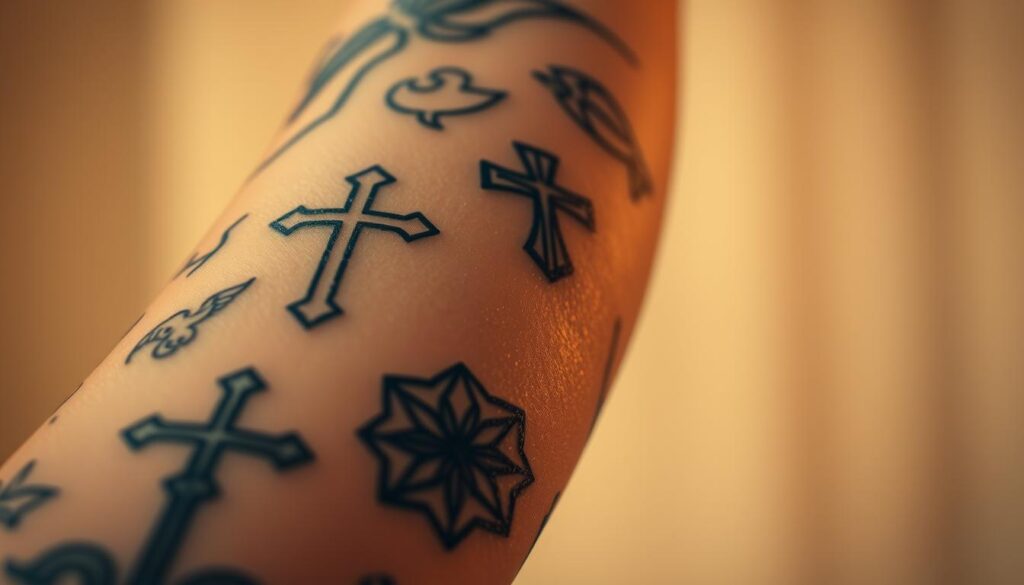
Is body art a sin? The answer might surprise you. As modern tattoos grow in popularity, countless believers wrestle with their spiritual implications. While scripture doesn’t directly address today’s ink culture, discussions about faith and self-expression continue to spark curiosity—and controversy.
Many people assume ancient texts offer clear rules about body markings. Yet the reality is far more nuanced. Passages often cited in debates—like Leviticus 19:28—originate from contexts vastly different from our current era. This raises questions about how to apply age-old principles to modern choices.
Differing interpretations across Christian traditions add layers to the conversation. Some view body art as harmless self-expression, while others see potential conflicts with spiritual values. Your journey through this topic will uncover how scripture, culture, and personal conviction intersect.
Key Takeaways
- Scripture contains no direct references to modern tattoo practices
- Interpretations vary widely among Christian denominations
- Historical context shapes understanding of body art principles
- Both Old and New Testament passages inform current debates
- Personal faith and cultural factors influence perspectives
Introduction: Understanding Tattoos in a Biblical Framework

Modern believers often wonder how ancient principles apply to today’s choices. The conversation about body art hinges on interpreting scripture through both historical and cultural lenses—not just quoting verses out of context.
Where Beliefs Collide With Culture
Some denominations strictly oppose tattoos, citing Leviticus 19:28 as timeless law. Others argue this passage addressed specific pagan rituals, not modern self-expression. Your perspective might shift when you consider:
- How cultural norms shaped ancient rules
- Why certain laws applied only to Israel’s covenant
- Whether symbolic meaning changes a tattoo’s spiritual impact
Bridging Ancient Texts and Modern Life
Early Christians avoided markings linked to idol worship. Today, many see body art as neutral—or even a way to honor faith. The key lies in discerning intent. Are tattoos rebellious acts or heartfelt declarations?
This debate mirrors larger questions about tradition versus personal conviction. While scripture doesn’t mention modern ink, it urges believers to glorify God in all things. Your choice ultimately reflects how you balance cultural relevance with spiritual wisdom.
Historical and Cultural Background of Biblical Tattoos

Ancient skin markings carried spiritual weight long before modern ink needles appeared. Body modifications served as ritualistic bridges between earthly life and divine realms across early civilizations.
Ritual Marks in Neighboring Cultures
Archaeologists found Egyptian women wore fertility symbols as permanent marks on hips and chests. These designs weren’t fashion statements—they sought divine protection during childbirth. Nearby Canaanite groups took body art further, slicing skin to honor gods or mourn losses.
Leviticus’ Boundary Lines
The Leviticus 19:28 prohibition specifically targeted pagan mourning practices. Its Hebrew phrasing warns against “cutting for the dead” and “writing marks”—direct references to idol-linked customs. This verse formed part of a holiness code separating Israel from neighboring cultures.
| Practice | Egyptian Purpose | Canaanite Purpose |
|---|---|---|
| Body Markings | Childbirth protection | Mourning rituals |
| Methods Used | Pigment-based tattoos | Skin cutting/branding |
| Spiritual Goal | Fertility blessings | Idol worship |
This context reshapes how we view the biblical prohibition. It wasn’t about art but avoiding spiritual contamination. Your understanding deepens when seeing these marks as ritual passports to other gods.
what does the bible say about tattoos in revelations

Scriptural symbols often spark modern debates. Revelation 19:16 describes a vision where Christ wears a blood-dipped robe bearing the title “King of Kings and Lord of Lords” on both fabric and thigh. Some suggest this implies divine approval for skin markings.
Symbolic Markings vs. Literal Skin Art
Ancient nobility displayed authority through woven titles and engraved weapons—not body ink. Scholars note that robe thigh references likely describe textile embroidery or sword scabbards, common royal identifiers in John’s era. This aligns with cultural practices rather than endorsing skin modifications.
Consider Christ’s Jewish identity. Observing Mosaic Law, He wouldn’t violate Leviticus’ prohibition against ritual marks. The name written on His thigh symbolizes universal reign, not physical tattooing. Revelation’s apocalyptic style uses vivid metaphors to convey spiritual truths.
| Interpretation | Cultural Practice | Theological Basis |
|---|---|---|
| Textile Embroidery | Royal garment designs | Honorific display |
| Weapon Engraving | Sword/scabbard inscriptions | Military authority |
| Symbolic Positioning | Visible while riding | Kingly prominence |
Your understanding deepens when separating metaphor from mandate. While some claim this thigh reference justifies modern tattoos, most theologians emphasize context. The passage highlights Christ’s supremacy—not body art guidelines.
Final thoughts? Revelation’s imagery invites awe, not imitation. Your personal convictions about name displays matter more than stretching symbolic visions into permission slips. Always weigh cultural relevance against scriptural intent.
Modern Perspectives: Tattoos, Faith, and Personal Expression

Faithful self-expression takes many shapes in today’s world. While some see skin art as conflicting with spiritual values, others find deep connections between their faith and body markings. This tension reveals how believers interpret scripture through modern lenses.
New Testament Insights on the Body as a Temple
Paul’s words in 1 Corinthians 6:19-20 spark diverse reactions. One camp views bodies as sacred vessels needing protection from permanent alterations. Another sees ink as honoring the “temple” through meaningful symbols—crosses, doves, or favorite verse references.
Sarah, a youth pastor, shares: “My forearm bears ‘walk by faith’ from 2 Corinthians. It sparks conversations about trusting God during tough times.” Her story shows how practices evolve when cultural context shifts.
Contemporary Christian Viewpoints and Personal Testimonies
Many cite Acts 15’s guidance about essential commandments. As one theologian notes: “The early church focused on heart posture, not ritual rules.” This mindset leads some to view getting tattooed as neutral—like choosing hairstyles forbidden in ancient times.
Consider these contrasting approaches:
- A missionary couple uses matching anchor designs to symbolize hope during overseas work
- A worship leader avoids ink to respect older congregants’ sensitivities
Both choices reflect thoughtful engagement with Romans 8:1’s promise of grace. Your decision ultimately hinges on whether body art enhances or hinders your spiritual life and witness.
Conclusion
Navigating faith-driven choices requires both wisdom and grace. When considering body art, your decision becomes a spiritual conversation rather than a simple yes-or-no answer. Prayerful reflection helps align personal desires with divine purpose—ask whether your choice honors God and serves others well.
Romans 14 reminds us that conscience guides individual paths. What brings one person closer to their faith might distract another. This principle applies beautifully to cultural expressions like ink. Historical context shows early prohibitions protected against idolatrous cultures, not artistic self-expression.
Your body serves as a living testament. Whether marked or unmarked, let it reflect love and reverence in daily life. The Lord looks beyond skin to the heart’s intentions. Seek guidance, respect differing views, and embrace freedom rooted in purposeful worship.
